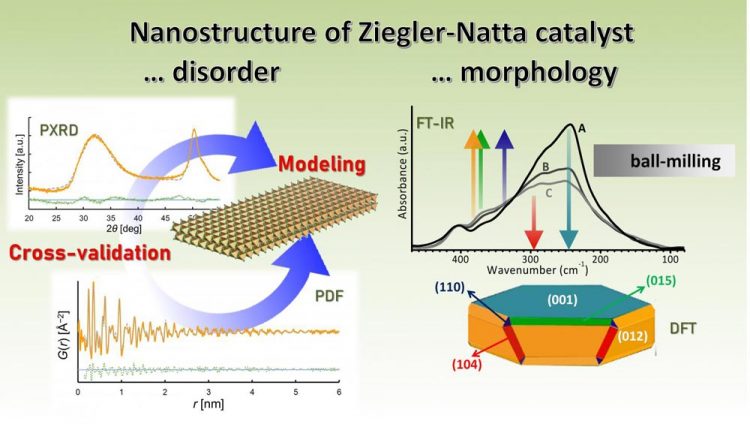Elucidation of nanostructures in practical heterogeneous catalysts

The nanostructure of the heterogeneous Ziegler-Natta catalyst was clarified on the basis of cutting-edge analytical techniques. Left: Typical synchrotron data and the determined nanoparticle model of the catalyst primary particle. Right: Experimental Far-IR spectra of a series of catalyst supports, and Wulff's polyhedra derived on the basis of surface formation energy. Credit: JAIST
Scientists from Japan Advanced Institute of Science and Technology (JAIST) and University of Torino (UNITO) have cooperatively clarified the nanostructure of the heterogeneous Ziegler-Natta catalyst by means of combined synchrotron X-ray analytical techniques, vibrational spectrocopies, and molecular simulations.
Understanding the structure and the working principle of practical catalysts is largely beneficial for designing catalysts towards desired performances.
However, this is often infeasible due to inherent complexity of such catalysts. The Ziegler-Natta catalyst is one of the most sophisticated practical catalysts for its performance in producing desired polyolefins at extremely high yield.
Nonetheless, the structure of the nanosized building unit of this catalyst has not been fully understood over six decades.
The collaborative research teams of Japan and Italy quantitatively determined the structural disorder and the dimensions of the building unit based on synchrotron X-ray total scattering analysis aided with molecular simulations.
Further, by combining infrared spectroscopies with state-of-the-art DFT simulations, the morphology and the surface exposure of the building unit were clarified.
The current research corresponds to the first attempt of adopting synchrotron X-ray total scattering and Far IR spectroscopy for the study of the Ziegler-Natta catalyst. Such the multi-faced approach successfully shed new light on the full elucidation of the nanostructure in practical heterogeneous catalysts.
###
Papers titled “Revisiting the identity of δ-MgCl2: Part I. Structural disorder studied by synchrotron X-ray total scattering”, and “Revisiting the identity of δ-MgCl2: Part II. Morphology and exposed surfaces studied by vibrational spectroscopies and DFT calculation”, both published in Journal of Catalysis, DOI: https:/
This research forms part of the research programme of DPI (P.O. Box 902, 5600 AX Eindhoven, the Netherlands), project #802.
Media Contact
More Information:
http://dx.doi.org/10.1016/j.jcat.2020.03.002All latest news from the category: Physics and Astronomy
This area deals with the fundamental laws and building blocks of nature and how they interact, the properties and the behavior of matter, and research into space and time and their structures.
innovations-report provides in-depth reports and articles on subjects such as astrophysics, laser technologies, nuclear, quantum, particle and solid-state physics, nanotechnologies, planetary research and findings (Mars, Venus) and developments related to the Hubble Telescope.
Newest articles

First-of-its-kind study uses remote sensing to monitor plastic debris in rivers and lakes
Remote sensing creates a cost-effective solution to monitoring plastic pollution. A first-of-its-kind study from researchers at the University of Minnesota Twin Cities shows how remote sensing can help monitor and…

Laser-based artificial neuron mimics nerve cell functions at lightning speed
With a processing speed a billion times faster than nature, chip-based laser neuron could help advance AI tasks such as pattern recognition and sequence prediction. Researchers have developed a laser-based…

Optimising the processing of plastic waste
Just one look in the yellow bin reveals a colourful jumble of different types of plastic. However, the purer and more uniform plastic waste is, the easier it is to…


